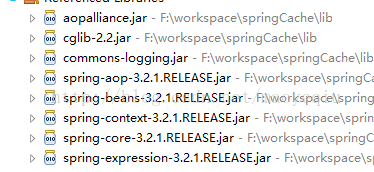java cache 学习记录之二
上一篇自定义了缓存的实现,不用任何第三方的组件来实现某种对象的内存缓存,这一篇结合结合上一篇的例子,简单的实现了spring cache,cache使用了spring缺醒的实现,包括缓存的查询、缓存的清空等。源码下载
首先,引入spring需要的jar包。如下图所示:
实体类既是上一篇中的user类,服务类:
package com.spricache.service;
import org.springframework.cache.annotation.CacheEvict;
import org.springframework.cache.annotation.Cacheable;
import com.spricache.entity.User;
public class UserService {
// 使用了一个缓存名叫 userCache ,value是user对象,key是userName
@Cacheable(value="userCache")
public User getUserByName(String userName) {
// 方法内部实现不考虑缓存逻辑,直接实现业务
System.out.println("数据库查询"+userName);
return getFromDB(userName);
}
// 清空 userCache 缓存 public void updateAccount(Account account)
//以这里还需要从参数 user 对象中获取 name 的值来作为 key,前面的 # 号代表这是一个 SpEL 表达式,此表达式可以遍历方法的参数对象
@CacheEvict(value="userCache",key="#user.getUserName()")
public void updateUser(User user) {
updateDB(user);
}
// 清空 accountCache 缓存
@CacheEvict(value="userCache",allEntries=true)
public void reload() {
}
private void updateDB(User user) {
System.out.println("更新数据库"+user.getUserName());
}
//模拟数据库查询
private User getFromDB(String acctName) {
System.out.println("正在从数据库查询"+acctName);
return new User(acctName);
}
}
@Cacheable(value=”userCache”),这个注释是当调用getUserByName这个方法的时候,从一个名叫 userCache 的缓存中查询,如果没有,则查询数据库,并将执行的结果存入缓存中,否则返回缓存中的对象。“userCache”缓存是在 spring*.xml 中定义的名称。
spring.xml的配置内容
<beans xmlns="http://www.springframework.org/schema/beans"
xmlns:xsi="http://www.w3.org/2001/XMLSchema-instance"
xmlns:cache="http://www.springframework.org/schema/cache"
xmlns:p="http://www.springframework.org/schema/p"
xsi:schemaLocation="http://www.springframework.org/schema/beans
http://www.springframework.org/schema/beans/spring-beans.xsd
http://www.springframework.org/schema/cache
http://www.springframework.org/schema/cache/spring-cache.xsd">
<!--支持缓存的配置项 ,这个配置项缺省使用了一个名字叫 cacheManager 的缓存管理器-->
<cache:annotation-driven />
<!--配置service变量 -->
<bean id="userService" class="com.spricache.service.UserService"/>
<!-- generic cache manager -->
<bean id="cacheManager" class="org.springframework.cache.support.SimpleCacheManager">
<property name="caches">
<set>
<bean class="org.springframework.cache.concurrent.ConcurrentMapCacheFactoryBean" p:name="default" />
<bean class="org.springframework.cache.concurrent.ConcurrentMapCacheFactoryBean" p:name="userCache" />
</set>
</property>
</bean>
</beans>
这里的p:name="userCache"既是在服务类的标签@Cacheable(value=”userCache”)中的usercache。这个缓存userCache使用了缺省的内存存储方案 ConcurrentMapCacheFactoryBean,它是基于 java.util.concurrent.ConcurrentHashMap 的一个内存缓存实现方案。
下边是测试类:
package com.spricache.test;
import org.springframework.context.ApplicationContext;
import org.springframework.context.support.ClassPathXmlApplicationContext;
import com.spricache.entity.User;
import com.spricache.service.UserService;
public class Test {
public static void main(String args[]){
// 加载 spring 配置文件
ApplicationContext context = new ClassPathXmlApplicationContext("com/spricache/config/spring-cache.xml");
UserService userService = (UserService) context.getBean("userService");
// 第一次查询,应该走数据库
System.out.println("第一次查询");
userService.getUserByName("helloSpringCache");
// 第二次查询,应该不查数据库,直接返回缓存的值
System.out.println("第二次查询");
userService.getUserByName("helloSpringCache");
System.out.println();
//更新某个记录的缓存,首先构造两个账号记录,然后记录到缓存中
System.out.println("开始测试清空缓存");
User user1 = userService.getUserByName("cache1");
User user2 = userService.getUserByName("cache2");
//开始更新其中一个
user1.setId(1212);
userService.updateUser(user1);
// 因为被更新了,所以会查询数据库
userService.getUserByName("cache1");
// 没有更新过,应该走缓存
userService.getUserByName("cache1");
// 再次查询,应该走缓存
userService.getUserByName("cache1");
// 更新所有缓存
userService.reload();
// 应该会查询数据库
userService.getUserByName("cache2");
// 应该会查询数据库
userService.getUserByName("cache1");
// 应该走缓存
userService.getUserByName("cache2");
// 应该走缓存
userService.getUserByName("cache1");
}
}
运行结果:

